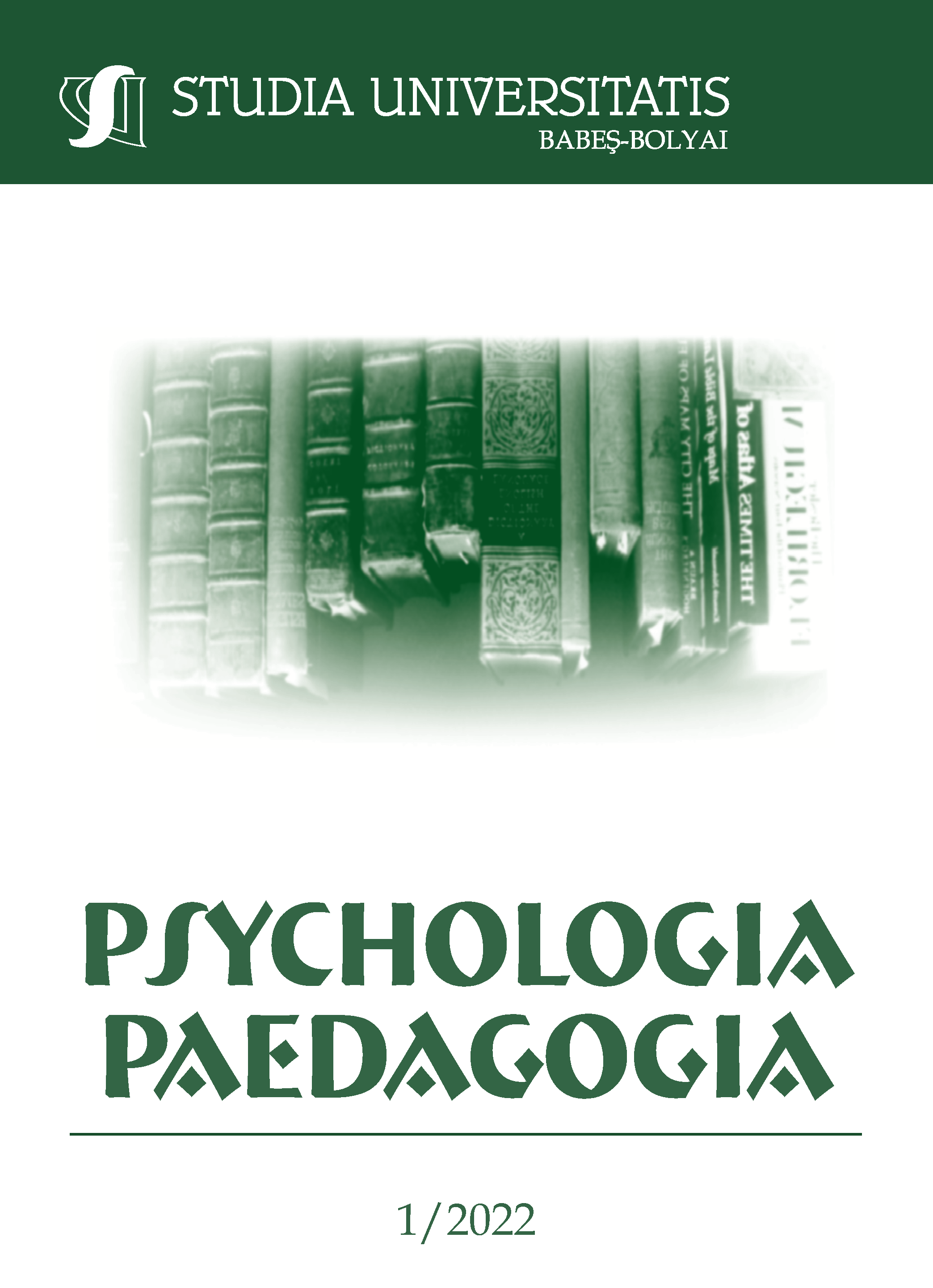12 STEPS AND ABSTINENCE: HOW DO I STAY SOBER?
DOI:
https://doi.org/10.24193/subbpsyped.2022.1.01Keywords:
12 step program, recovery, abstinence, efforts of sobriety, perceived stress, subjective well-beingAbstract
The present study was conducted among 12-steps communities of recovery (Alcoholics Anonymous, Narcotics Anonymous) in Hungary. As these communities become more and more frequented, it is of interest to explore how recovering addicts implement their specific program of recovery and what psychological characteristics are affected by this process. The study presumed that longer time in abstinence predicted lower levels of chronic stress and higher levels of subjective well-being, given that participants were working actively on their sobriety/recovery. Thus, it was assumed that more intense work on sobriety would lead to lower levels of stress and higher levels of well-being. After filtration, N = 148 recovering addicts were included in the study. The participants completed a test-battery including queries on sobriety efforts (SEQ); Perceived Stress Survey (PSS-13) and the shortened version of WHO’s well-being questionnaire (WB15). The results show that abstinence doesn’t influence levels of stress neither in itself nor through active work on recovery. Nevertheless, a more intense work on sobriety (adhering to the 5 suggestions of 12 step program) predicted higher levels of subjective well-being. Recovering addicts commit themselves most actively to the recommendations of the 12-step communities during their first to five years of their abstinence. Our study makes a stand for anonymous recovery programs and argues that active efforts of maintaining sobriety are essential for sustainable recovery and long-term sobriety, and adherence to the five recommendations of these 12-step communities predict subjective well-being.
Received: 2022 March 05; Revised: 2022 March 25; Accepted: 2022 March 28; Available online: 2022 May 5; Available print: 2022 May 30
References
DeLucia, C., Bergman, B. G., Formoso, D., & Weinberg, L. B. (2015). Recovery in Narcotics Anonymous from the perspectives of long-term members: A qualitative study. Journal of Groups in Addiction & Recovery, 10(1), 3–22.
Emrick, C.D. & Beresford, T.P. (2016). Contenporary negative assessments of Alcoholics Anonymous: A response. Alcoholism Treatment Quarterly, 34(4), 463–471.
Galanter, M., Dermatis, H., Post, S., & Santucci, C. (2013). Abstinence from drugs of abuse in community-based members of Narcotics Anonymous. Journal of Studies on Alcohol and Drugs, 74(2), 349–352.
Gonzales. R., Anglin, M. D., Beattie, R. [...] & Glik, D. C. (2012). Understanding recovery barriers: Youth perceptions about substance use relapse. American Journal of Health Behavior, 36(5), 602–614.
Greenfield, B. L., & Tonigan, J. S. (2012). The general Alcoholics Anonymous tools of recovery: The adoption of 12-step practices and beliefs. Psychology of Addictive Behaviors, 27(3), 553–561.
Hagen, E., Erga, A., Hagen, K., Nevsag, S., McKay, J. Lundervold, A. & Walderhaug, E. (2017). One-year sobriety improves satisfaction with life, executive functions and psychological distress among patients with polystubstacne use disorder. Journal of Substance Abuse Treatment, 76, 81–87.
Haleem D. J. (1996). Adaptation to repeated restraint stress in rats: Failure of ethanol-treated rats to adapt in the stresss chedule. Alcohol & Alcoholism, 31, 471–477.
Hosseini, F., Ardekani, S.M.Y., Kordi, A., Farzinrad, B., & Musazadeh, M. (2016). Quality of life among Narcotic Anonymous male members in Yazd City, Iran. International Journal of High Risk Behavior & Addiction, e31275 DOI: 10.5812/ijhrba.31275
Humphreys, K., Mankowski, E. S., Moos, R. H., Finney, J. W. (1999) Do enhanced friendship networks and active coping mediate the effect of self-help groups on subtance abuse? Substance AbuseSelf-HelpGroups, 21(1).
Laudet, A. B., & White, W. L. (2008). Recovery capital as prospective predictor of sustained recovery, life satisfaction, and stress among former poly-substance users. Substance use & misuse, 43(1), 27–54. doi:10.1080/10826080701681473
Lefever, R. (2000) Kickthe Habit. Overcoming addiction using the. Twelve-step programme. London. CarltonBooks.
Kelly, J. F., Magill, M., & Stout, R. L. (2009). How do people recover from alcohol dependence? A systematic review of the research on mechanisms of behavior change in Alcoholics Anonymous. Addiction Research & Theory, 17(3), 236–259.
Majer, J. M., Jason, L. A., Aase, D. M., Droege, J. R., & Ferrari, J. R. (2013). Categorical 12step involvement and continuous abstinence at 2 years. Journal of Substance Abuse Treatment, 44(1), 46–51
McLellan. A. T. (2009). Mi a felépülés? A Betty Ford Institute konszenzusos paneldefiníciójának újratárgyalása. Addiktológia, 8 (1), 115–118.
N.A.W.S. (2012). Narcotics Anonymous Basic Text. N.A. World Service. Van Nuys. CA
Nagy, Zs., (2014). Józanságmunka a felépülésben. In Erdős M., Márk, M. (Eds.), Felépülő közösségek. Pécs. Pro Pannónia Kiadói Alapítvány.
Nagy, Zs. (2018). Az üveghegyen túl. A felépülés életrendje és értékrendje 12 lépéses programokban józanodó szerfüggők körében. Budapest, Magyarország: L’Harmattan kiadó.
Subbaraman, M. S., Kaskutas, L. A., & Zemore, S. (2011). Sponsorship and service as mediators of the effects of Making Alcoholics Anonymous Easier (MAAEZ), a 12-step facilitation intervention. Drug and Alcohol Dependence, 116(1-3), 117–124. doi: 10.1016/j.drugalcdep.2010.12.008
Szántó, Zs., Susánszky, É., Berényi Z., Sipos, F., Murányi, I. (2016). A jól-lét fogalmának értelmezése az európai szakirodalomban (2009-2014). Metszetek,5(1).
The jamovi project (2020). jamovi. (Version 1.2) [Computer Software]. Retrieved from https://www.jamovi.org
Yang, C., Xia, M. Liang, H., & Ying, L. (2018). Social support and resilience as mediators between stress and life satisfaction among people with substance use disorder in China. Frontiers in Psychiatry, 9, October. DOI: 10.3389/fpsyt.2018.00436
Wendt, D.C., Hallgren, K.A., Daley, D. & Donovan, D. (2017). Predictors and outcomes of Twelve-Step sponsorship of stimulant users: Secondary analyses of a multisite randomized clinical trial. Journal of Studies on Alcohol & Drugs, 78, 287–295.
White, W. (2012). Commentary: Are the AA and NA skies falling? Addiction Research and Theory, 20(2), 105–106.
https://www.aa.org/assets/en_US/smf-132_en.pdf Last downloaded: 16/09/2020
http://nahungary.hu/gyuleslista/ Last downloaded: 16/09/20
Downloads
Published
How to Cite
Issue
Section
License
Copyright (c) 2022 Studia Universitatis Babeș-Bolyai Psychologia-Paedagogia

This work is licensed under a Creative Commons Attribution-NonCommercial-NoDerivatives 4.0 International License.


